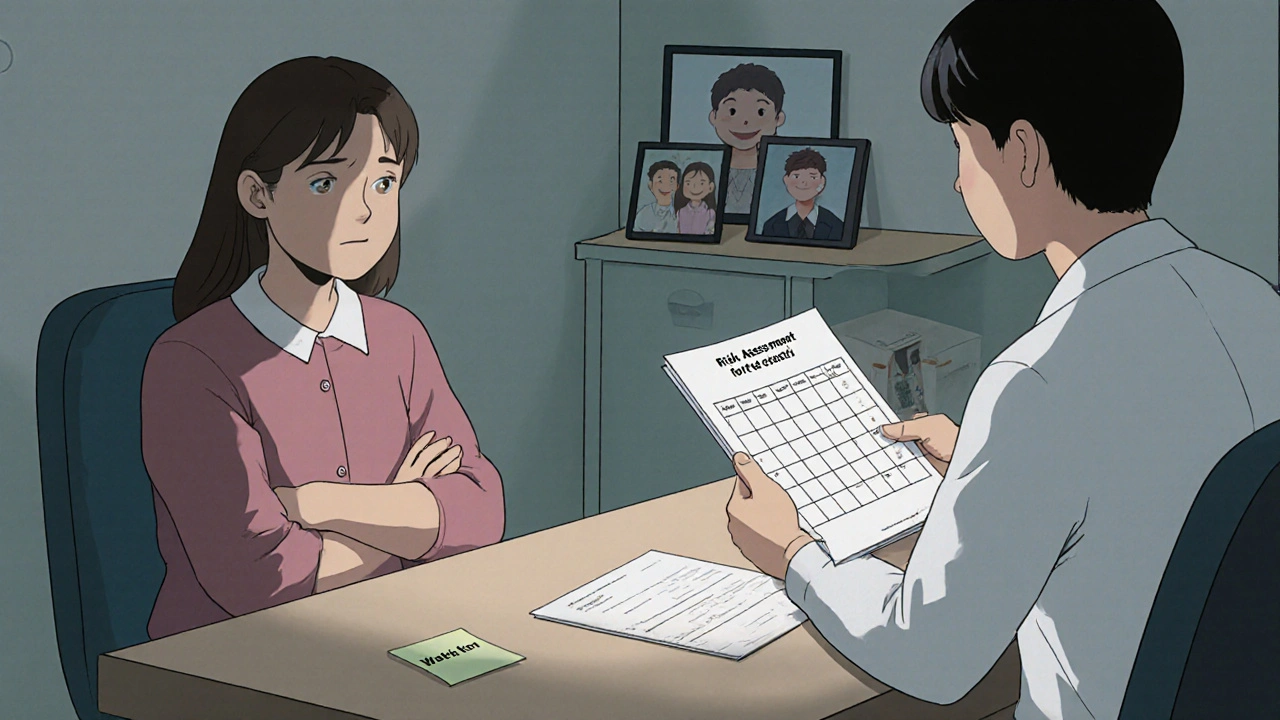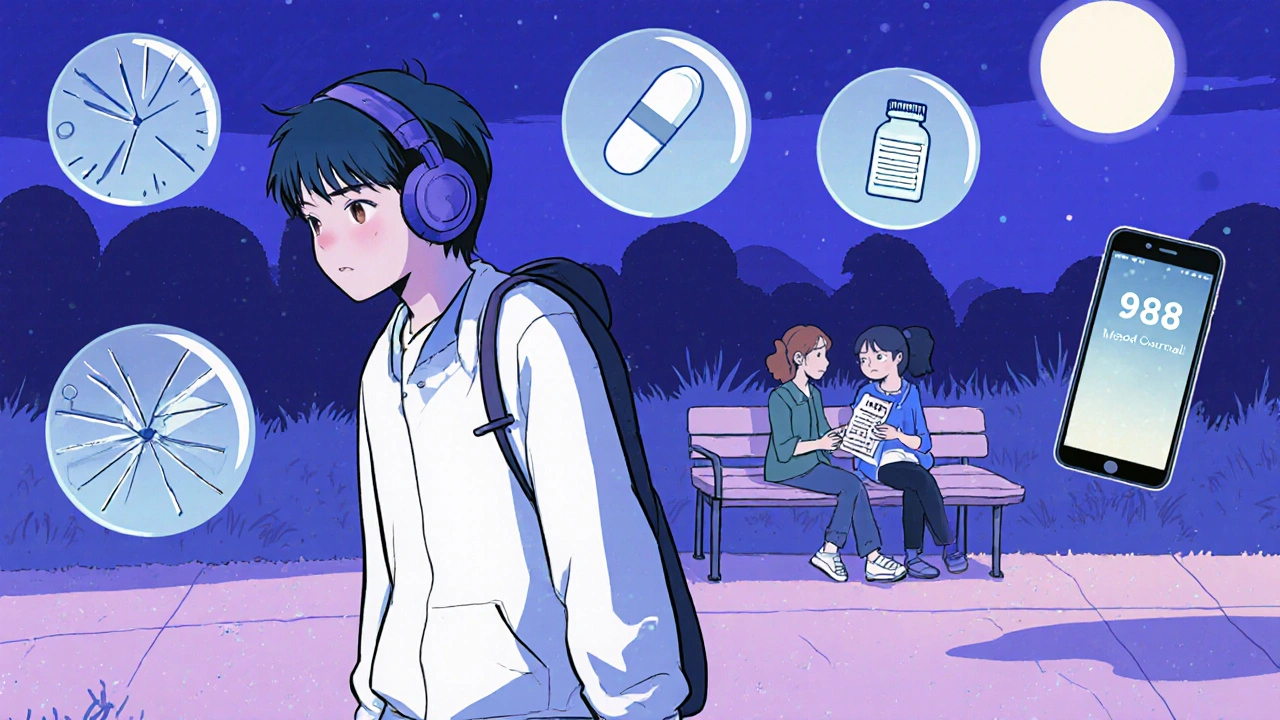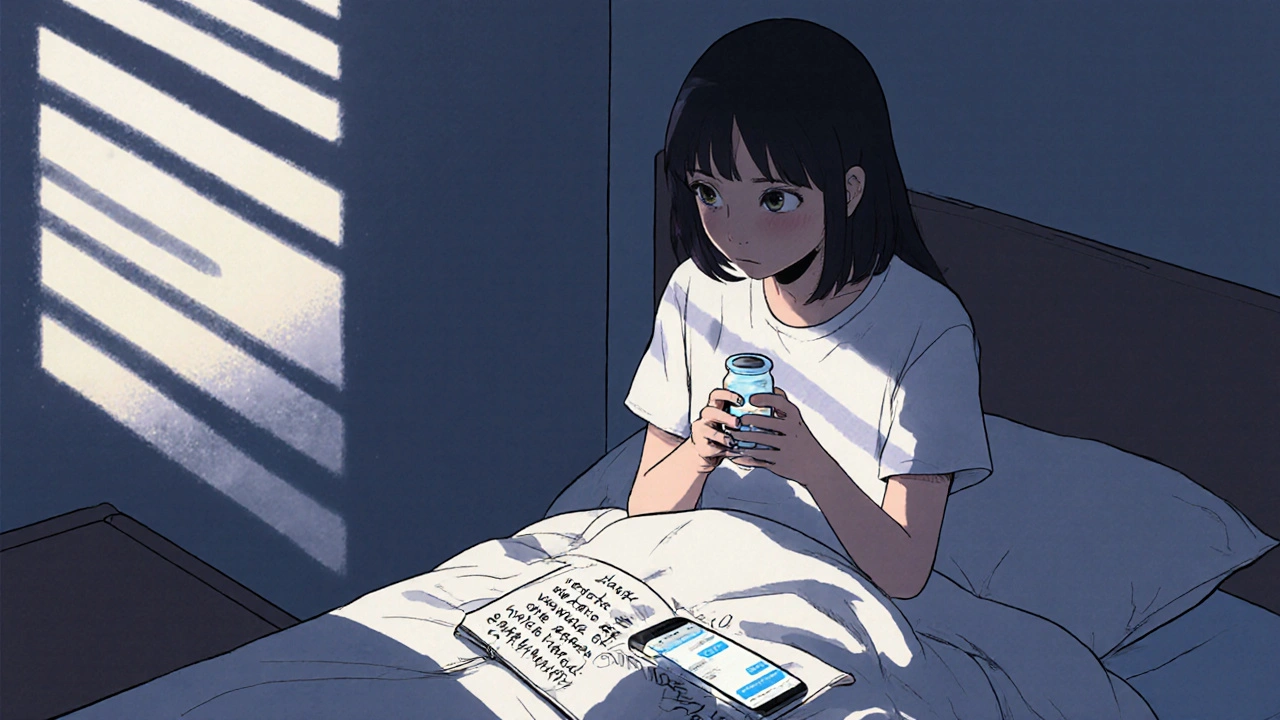Adolescent Psychiatric Medication Risk Assessment Tool
Risk Assessment
This tool helps identify risk factors based on current clinical guidelines. Select all that apply:
When a teenager starts taking psychiatric medication, the goal is relief - less anxiety, better sleep, fewer panic attacks. But for some, the very treatment meant to help can trigger something dangerous: suicidal ideation. It’s not common, but it’s real enough that every clinician, parent, and school counselor must know how to watch for it - and what to do next.
Why Teens Are at Higher Risk
The U.S. Food and Drug Administration (FDA) added a black box warning to antidepressants in 2004 after studies showed a small but measurable rise in suicidal thoughts among kids and teens in the first few weeks of treatment. This wasn’t about the drugs causing suicide - it was about how the brain changes when medication starts working. As energy returns before mood improves, some adolescents gain the physical ability to act on thoughts they were too depressed to act on before. It’s not just antidepressants. Antipsychotics, mood stabilizers, even stimulants used for ADHD can carry this risk. A 2023 review by MedPsych Health found that suicidal ideation can emerge with any psychiatric medication, regardless of class. The risk peaks in the first 1-4 weeks after starting or changing a dose, and again during tapering or discontinuation.Who Needs the Closest Monitoring?
Not every teen needs weekly check-ins. But certain factors raise the red flags:- History of suicide attempts or self-harm
- Recent major loss (death, breakup, moving)
- Family history of suicide
- Co-occurring substance use
- Severe depression or agitation at baseline
- Previous negative reaction to medication
What to Watch For - Real Signs, Not Just Warnings
Suicidal ideation doesn’t always come with a note or a dramatic statement. Often, it’s quiet. Look for:- Changes in sleep - waking up too early, sleeping too much, or refusing to get out of bed
- Withdrawal from friends, even close ones
- Sudden calm after a period of extreme distress - this can mean they’ve made a decision
- Talking about being a burden, feeling trapped, or having no future
- Giving away prized possessions
- Writing or drawing dark themes - not just goth music, but actual imagery of death or escape

How Often Should You Check In?
The frequency of monitoring isn’t one-size-fits-all. Here’s what leading guidelines recommend:- First 4 weeks: Weekly visits or calls. Some states like New York require documentation of suicide risk assessment at every visit during this time.
- Weeks 5-12: Every two weeks, unless symptoms worsen.
- After 12 weeks: Monthly, unless the teen is high-risk or the dose is being changed.
- During tapering: Back to weekly - or even twice weekly. Stopping meds too fast can trigger withdrawal symptoms that mimic or worsen suicidal thoughts.
What Parents and Caregivers Can Do
You’re not just a bystander. You’re part of the safety team.- Keep all medications locked up. Even a few extra pills can be deadly.
- Ask direct questions: “Have you had thoughts about not wanting to be alive?” Don’t fear the word “suicide.” It doesn’t plant the idea - ignoring it does.
- Track mood changes in a simple journal: date, sleep, appetite, energy, any talk of hopelessness.
- Coordinate with school counselors. A 2022 survey found 68% of clinicians reported poor communication between schools and outpatient providers. Don’t let your teen fall through the cracks.
- Know the emergency plan: Crisis Text Line (text HOME to 741741), 988 Suicide & Crisis Lifeline, or your provider’s after-hours number.
The Role of the Prescriber
Doctors aren’t just writing prescriptions. They’re managing risk. Leading guidelines - from AACAP to NYC’s Department of Social Services - require that before any medication is started, the clinician must:- Document the reason for prescribing
- Explain the risk of suicidal ideation to both teen and parent
- Get informed consent - not just a signature, but a conversation
- Set a clear monitoring schedule
- Plan for discontinuation before even starting

When Medication Might Need to Change
Sometimes, the best treatment is stopping. But stopping isn’t simple. Abruptly cutting a drug can cause rebound anxiety, insomnia, irritability - symptoms that look like worsening depression. California’s guidelines say clinicians must ask: “Is the medication helping more than it’s hurting?” If the teen says it’s not helping, or if suicidal thoughts appear, the plan must include:- Gradual tapering, not sudden stop
- More frequent check-ins during taper
- Alternative treatments - therapy, lifestyle changes, different meds
- Documentation of why the drug is being discontinued
What’s Missing in Today’s System
There’s a gap between what guidelines say and what happens in real life. Many clinics still focus only on weight, blood pressure, or lab tests - not mental state. Some state guidelines, like Florida’s, barely mention suicide risk at all. Also, digital tools are emerging - 38% of practices now use electronic suicide risk screens - but only 19% are designed to track medication-specific changes. Most tools ask, “Are you suicidal?” - not “Did your suicidal thoughts start after you began this drug?” And training? Only 34% of child psychiatry residents get the 8+ hours of specialized training recommended by AACAP. That means too many providers are flying blind.The Bottom Line
Psychiatric medication can be life-changing for teens. But it’s not a quick fix. It’s a medical intervention with real risks - and those risks demand real attention. If your child is on medication, you need to know:- What signs to watch for
- How often to check in
- Who to call if things go wrong
- That stopping meds safely is just as important as starting them
Can psychiatric medication cause suicidal thoughts in teens?
Yes, in a small number of cases. The FDA issued a black box warning in 2004 after studies showed an increased risk of suicidal thinking in children and teens during the first few weeks of antidepressant use. This risk also exists with other psychiatric medications, including antipsychotics and mood stabilizers. The mechanism isn’t fully understood, but it may involve increased energy returning before mood improves, giving teens the physical ability to act on thoughts they previously lacked the strength to act on.
How often should a teen on psychiatric medication be monitored for suicidal ideation?
Monitoring frequency depends on risk level and treatment phase. For most teens, weekly check-ins are recommended during the first 4 weeks after starting or changing a medication. After that, every two weeks for weeks 5-12, then monthly if stable. During tapering or discontinuation, monitoring should increase to weekly or even twice weekly. High-risk teens - those with prior suicide attempts or severe depression - may need even more frequent contact, sometimes daily at first.
What should parents do if their teen expresses suicidal thoughts while on medication?
Take it seriously. Do not leave the teen alone. Contact their prescriber immediately. If the provider is unavailable, call 988 (Suicide & Crisis Lifeline) or go to the nearest emergency room. Do not wait to see if it passes. Document what was said, when, and under what circumstances. Avoid minimizing comments like “You’re just being dramatic.” Instead, say, “I’m here. Let’s figure this out together.”
Is it safe to stop psychiatric medication if suicidal thoughts appear?
Never stop abruptly. Stopping suddenly can cause withdrawal symptoms - including increased anxiety, insomnia, and worsening mood - that may look like or even trigger suicidal ideation. If suicidal thoughts emerge, contact the prescribing clinician right away. They will guide a safe, gradual taper, often with more frequent check-ins. The goal is to reduce the medication slowly while watching for signs of relapse or worsening symptoms.
Are there tools to help track suicidal ideation at home?
Yes. Simple tools like daily mood journals or free apps like the Columbia Suicide Severity Rating Scale (C-SSRS) can help track changes over time. Parents can note sleep patterns, energy levels, social withdrawal, and any statements about hopelessness. Some clinics use digital platforms that send automated check-ins to teens and parents. But no app replaces human connection. The most effective tool is consistent, open conversation - asking directly and listening without judgment.
Why don’t all doctors follow the same monitoring guidelines?
Guidelines vary by state, clinic, and provider training. While organizations like AACAP and the FDA provide clear standards, not all clinicians receive adequate training in suicide risk assessment. Some face time pressures, insurance limitations, or lack access to specialized resources. In rural or underfunded areas, monitoring may be inconsistent. Parents should not assume their provider is following best practices - they need to ask questions and insist on a clear monitoring plan before starting any medication.
Can therapy replace medication for teens with suicidal ideation?
Therapy, especially cognitive behavioral therapy (CBT) or dialectical behavior therapy (DBT), is highly effective for reducing suicidal thoughts - often more so than medication alone. Many experts recommend combining therapy with medication, especially for moderate to severe cases. For some teens, therapy alone may be enough. But if suicidal ideation is severe or linked to a biological condition like major depression or bipolar disorder, medication may still be necessary. The goal is not to choose one over the other, but to use both strategically under professional guidance.


Cameron Daffin
November 1, 2025 AT 21:53Man, this post hit different. I’ve seen my little sister go through this - started on an SSRI after a breakup, and for two weeks she was this zombie who smiled at nothing. Then one day she just said, ‘I don’t know why I’m still here.’ Didn’t scream, didn’t cry. Just… stated it like the weather. We called her psychiatrist that night. They adjusted the dose in 48 hours. It’s not the meds themselves - it’s the brain catching up. Energy before mood. That’s the trap. Don’t wait for a note. Watch the silence.
Carlo Sprouse
November 2, 2025 AT 03:49While I appreciate the attempt at clinical rigor, this piece fundamentally misunderstands the pharmacological dynamics at play. The FDA black box warning was based on underpowered studies with high attrition bias. The actual incidence of suicidal ideation in controlled trials is 1.2% versus 0.8% in placebo - a statistically insignificant delta. What we’re witnessing here is not a pharmacological phenomenon, but a societal over-medicalization of adolescent emotional development. The real danger isn’t the medication - it’s the normalization of pharmacological intervention as a first-line response to transient distress. We’ve replaced resilience training with pill schedules.
Rachel M. Repass
November 2, 2025 AT 04:08Let’s talk about the elephant in the room: we’re treating symptoms, not systems. A teen on meds is often a teen in a home where communication is transactional, not relational. Where school counselors are stretched thin, and parents are working two jobs just to keep the lights on. The medication isn’t the problem - the ecosystem is. I’ve seen kids stabilized on SSRIs who then spiral because their mom can’t afford therapy copays, or their dad thinks ‘talking about feelings’ is weakness. We need to fund the whole damn pipeline - not just the prescription pad. If you’re going to give a kid a drug that can trigger ideation, you better have a therapist on speed dial, a parent who knows how to ask the right questions, and a school that doesn’t treat mental health like an afterthought.
And yes - lock up the pills. But also lock up the stigma. Ask ‘Are you safe?’ not ‘Are you suicidal?’ The language matters. The tone matters. The presence matters.
Kristen Magnes
November 2, 2025 AT 23:59I’m a school counselor. We had a kid last semester - 15, on Adderall for ADHD. Started sleeping 14 hours a day, stopped texting his best friend. Said he felt ‘empty inside.’ We called his mom. She said, ‘He’s just being dramatic.’ We called his prescriber. He said, ‘It’s probably just adjustment.’ We called 988. We got him in for an emergency eval. Turned out the Adderall was triggering severe anxiety. They switched him to a non-stimulant. Three weeks later, he drew a picture of a sunrise and wrote ‘I think I’m gonna be okay.’ That’s what this is about. Not data. Not guidelines. One kid. One moment. One adult who didn’t look away.
Tom Hansen
November 3, 2025 AT 14:12bro the fda is just scared of lawsuits lmao they put black boxes on everything now. like my cousin took zoloft and got suicidal?? nah he just got bored of his life and wanted attention. parents these days are too soft. just tell the kid to suck it up and go outside. no one ever died from not getting a pill. also why are we giving teens antidepressants like they’re candy? i was 16 and i had zero mental health care and i turned out fine. stop overthinking everything.
Donna Hinkson
November 4, 2025 AT 04:47I’m from the UK and I’ve worked in youth mental health for 18 years. The thing I see most isn’t the medication - it’s the isolation. A teen on psychiatric drugs is often the only one in their house who’s trying to get better. Everyone else is too busy, too tired, too afraid to ask. I’ve sat with kids who’ve said, ‘I don’t want to die. I just don’t want to feel like this anymore.’ And the meds? They can help. But only if someone is sitting with them while they take them. Not texting. Not scrolling. Just… there. That’s the real monitoring tool. Presence. Not protocols.
Steve Dressler
November 5, 2025 AT 22:24Let’s not pretend this is just about dosing schedules. This is a failure of infrastructure. In 2024, a kid in rural Ohio can’t get a therapist within 6 weeks. Meanwhile, the clinic down the road has a 12-minute appointment slot and a checklist that says ‘assess for suicidality’ - and they click ‘no’ because the kid smiled when they walked in. We’re not managing risk. We’re managing paperwork. And when the kid crashes? It’s ‘unforeseen.’ No. It’s preventable. If you’re prescribing, you’re responsible. Not just for the script - for the follow-up. If your clinic doesn’t have a suicide risk protocol that’s documented, reviewed, and rehearsed - you’re not a clinician. You’re a dispenser.
Arthur Coles
November 7, 2025 AT 15:15EVERYTHING IS A GOVERNMENT PLOY. The FDA, AACAP, Big Pharma - they’re all in bed together. They want you to believe meds are the answer so you’ll keep buying them. The real reason teens get suicidal on meds? Because the drugs are laced with neurotoxins designed to keep them docile. Look at the patents. Look at the funding. The ‘black box warning’? A cover. The real danger is the surveillance state they’re building - tracking moods, linking school records, feeding data to insurance algorithms. They’re not protecting kids. They’re profiling them. Wake up. Your child’s ‘suicidal ideation’? It’s a symptom of a system trying to control them. Ask yourself: who profits when a kid stays on meds for life?
Sharron Heath
November 7, 2025 AT 20:39As a licensed clinical social worker with over two decades of experience in adolescent psychiatry, I must emphasize that the data supporting the risk of suicidal ideation with psychiatric medication is both robust and ethically non-negotiable. The concern is not theoretical - it is clinical, measurable, and deeply human. What is often overlooked is that the same biological mechanisms that allow for improved mood regulation - increased serotonin transporter occupancy, neuroplasticity modulation - can also temporarily destabilize emotional thresholds in developing prefrontal cortices. This is not a flaw in treatment; it is a feature of neurodevelopment. The solution is not avoidance - it is vigilance, collaboration, and structured, time-bound monitoring. Parents, clinicians, and educators must operate as a triad. One cannot succeed without the others. This is not an opinion. It is standard of care.
adam hector
November 9, 2025 AT 09:37Let me tell you something nobody else will: we’ve turned adolescence into a medical condition. You don’t need a pill to feel sad after your first breakup. You need a hug. A walk. A parent who doesn’t check their phone. But we’ve outsourced emotional maturity to psychiatrists and pharmacists. Now we’re raising a generation that thinks feelings are bugs to be patched. The real crisis isn’t suicidal ideation - it’s the loss of meaning. When you tell a kid their pain is a chemical imbalance, you’re telling them they’re broken. Not human. And that’s the most dangerous drug of all.